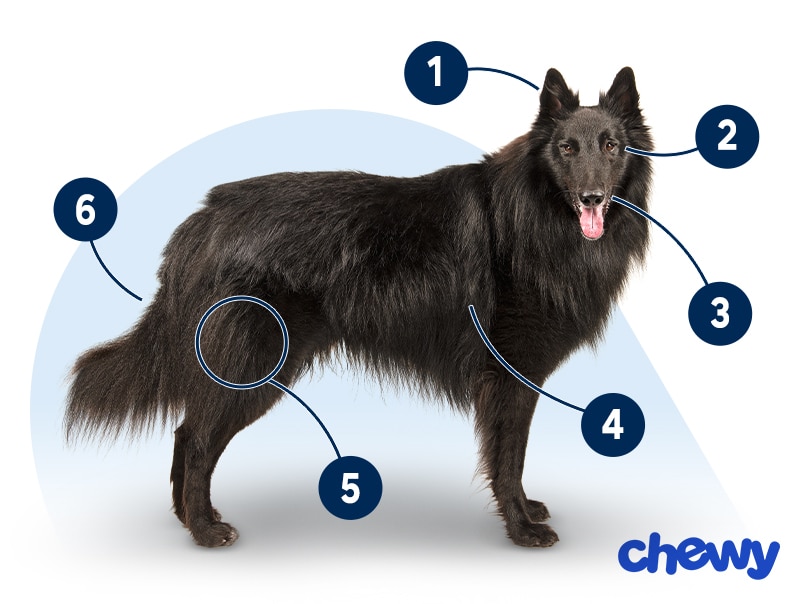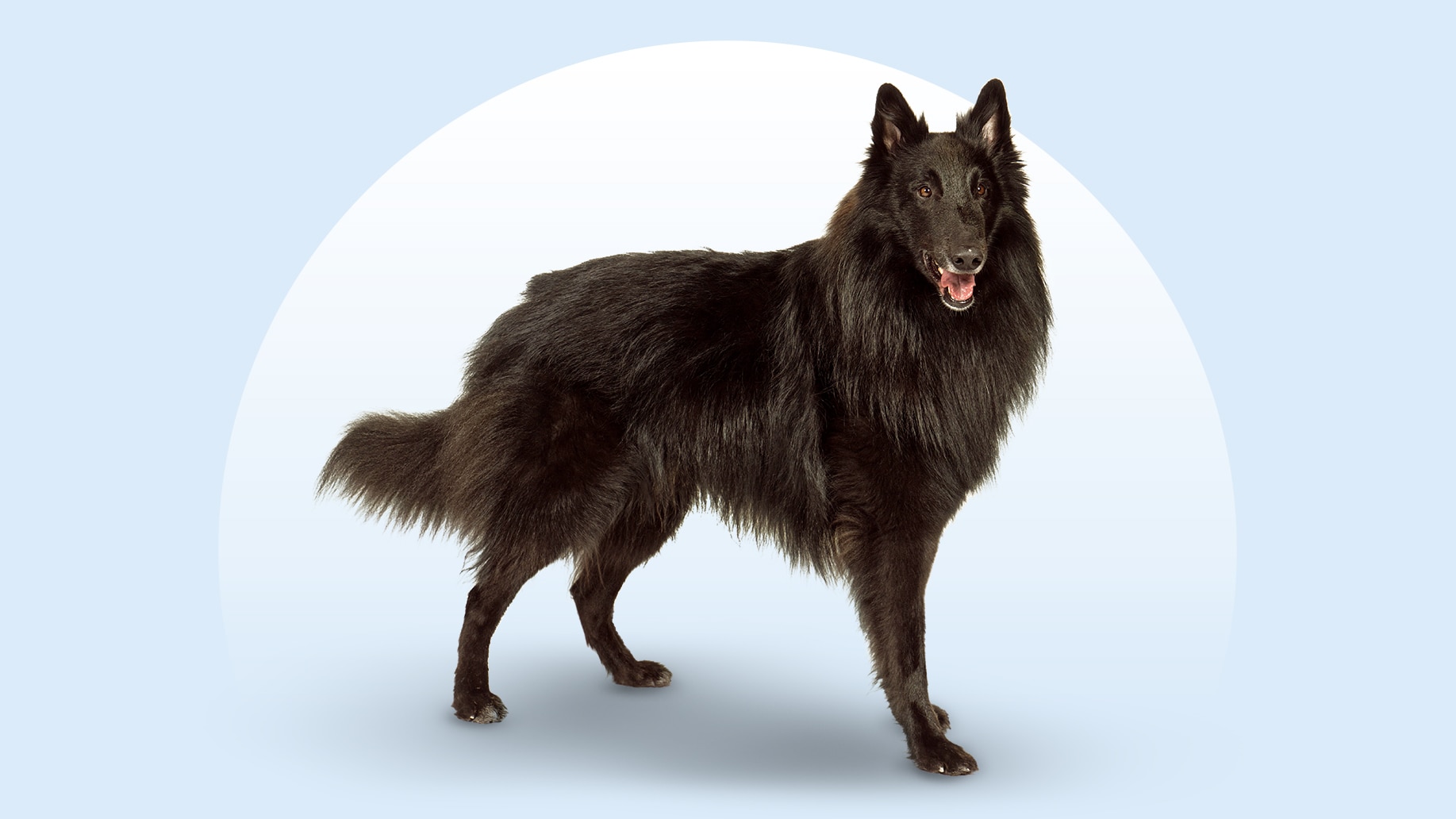Belgian Sheepdog (Groenendael)
Updated September 24, 2025
Belgian Sheepdog (Groenendael)
Updated September 24, 2025
The Belgian Sheepdog (aka Groenendael) is a smart herding breed known for their striking black coat. Energetic and loyal, Groenendaels thrive on daily exercise, consistent training, and close companionship. They require regular grooming and an active family who provides structure and stimulation.
Alert, Devoted, Intelligent
45–75 pounds
22–26 inches
12–14 years
Black, Black and White
Thinking about a Belgian Sheepdog? Buckle up! These devoted Velcro dogs come with brains, beauty, and boundless energy.
The most striking feature of the Belgian Sheepdog is their sleek, black coat. It turns heads, but it also demands regular brushing, so make sure you have time in your daily schedule for a grooming session.
You’ll also need to budget in daily runs, agility training, or other fast-paced activities; this breed won’t settle for a couch-potato lifestyle. So, if you’re outdoorsy and looking for a workout buddy, the Belgian Sheepdog might be your perfect match.
Belgian Sheepdog (Groenendael) Characteristics
Belgian Sheepdog (Groenendael) Appearance
Belgian Sheepdogs are an elegant, muscular, and agile herding breed distinguished by their glossy black coat and proud posture. They have a distinct square build with sharply defined features, upright triangular ears, and almond-shaped eyes.
In short, they are gorgeous.

- Ears
Their ears are triangular, stiff, and erect. They’re set high on the head, enhancing the Belgian Sheepdog’s alert expression.
- Eyes
Medium-size, almond-shaped, and dark brown, the Groenendael’s eyes hold an intelligent, attentive gaze.
- Nose
Their nose is as black as their fur and sits on the end of a long snout.
- Coat Length
Their medium to long dense double coat has a thicker ruff around the neck and requires regular grooming.
- Coat Color
All Belgian Sheepdogs are solid black, but they can have occasional small white markings on the chest, toes, or muzzle.
- Tail
The tail is bushy and moderately long, carried low with an upward curve at the tip.
Belgian Sheepdog (Groenendael) Temperament
The Belgian Sheepdog temperament is a balance of loyalty, sensitivity, and spirit. These smart dogs are devoted to their families and form strong bonds with their humans.
Belgian Sheepdogs tend to be reserved around new people, but they’ll warm up once they’re properly introduced. With proper socialization, a Belgian Sheepdog can get along well with children and other dogs and pets, though their herding instinct may lead them to try to “organize” the household.
While this household herding isn’t an appropriate outlet, the Groenendael dog breed thrives when they have a purpose. This four-legged workaholic excels in herding, agility, obedience, and tracking.
Their sharp minds and high energy make them best suited to active, experienced pet parents who can provide plenty of structure, training, and mental stimulation. Without it, Belgian Sheepdogs can become bored or anxious. But in the right home, they’re loyal, driven, and endlessly rewarding companions.
How to Care for a Belgian Sheepdog (Groenendael)
Caring for a Belgian Sheepdog means living an active lifestyle. With the right guidance, living with a Belgian Sheepdog is incredibly rewarding—but they’re not a low-maintenance breed and won’t be happy as couch potatoes.
Grooming
Training
Diet
Exercise
Environment
Belgian Sheepdog (Groenendael) Health
The average Belgian Sheepdog lifespan is 12–14 years. While they’re generally a healthy and robust breed, responsible breeding and routine vet care are key to having the healthiest dog possible.
Here are some health issues Belgian Sheepdogs may experience in their lifetime:
- Hip dysplasia: A common issue in many medium-to-large breeds, hip dysplasia is a genetic condition where the hip joint doesn’t fit properly into the socket. Over time, this can lead to pain, lameness, or arthritis in dogs. It’s important to keep your dog at a healthy weight to help reduce strain on the joints.
- Elbow dysplasia: Elbow dysplasia involves abnormal joint development. It can cause lameness, pain, and mobility issues, especially in active dogs like the Belgian Sheepdog. Treatment may involve medication, lifestyle changes, or (in severe cases) surgery.
- Progressive retinal atrophy (PRA): PRA in dogs is a group of genetic diseases that causes the retina (the part of the eye that detects light) to degenerate over time, eventually leading to blindness in dogs. While there’s no cure, the condition is painless and manageable.
- Epilepsy: Belgian Sheepdogs may be prone to idiopathic epilepsy, a neurological disorder that causes recurring seizures. Many dogs with this condition live full lives with proper diagnosis and lifelong medication.
- Gastric dilatation-volvulus (GDV): As a deep-chested breed, Belgian Sheepdogs are at risk for bloat, a life-threatening condition where the stomach distends with gas and/or food. Sometimes bloat progresses into gastric dilatation-volvulus, where the stomach twists and cuts off blood supply to abdominal organs. Signs include a distended abdomen; pacing and restlessness; excessive drooling; and retching without vomiting. Immediate veterinary attention is vital.
Belgian Sheepdog (Groenendael) History
The Belgian Sheepdog is one of four closely related herding breeds developed in Belgium during the late 1800s. All four varieties—the Groenendael, Malinois, Tervuren, and Laekenois—share the same foundation and working heritage, and they’re distinguished primarily by coat type and color.
These dogs were originally bred for herding sheep and guarding livestock, and they were prized for their intelligence, agility, and intense work ethic, according to the Belgian Sheepdog Club of America.
Over time, their versatility made them popular not only on farms but also in roles like police work, military service, search and rescue, and as guide dogs.
The American Kennel Club officially recognized the Belgian Sheepdog in 1912. Today, the Belgian Sheepdog continues to stand out as a devoted, driven companion both at home in the field, on the job, or with an active family.
If you’re interested in bringing home a Belgian Sheepdog puppy, look for a reputable breeder who prioritizes the health of their dogs. You can also search breed-specific rescues, like the Belgian Sheepdog Rescue Trust, to find a dog in need of a loving home.






